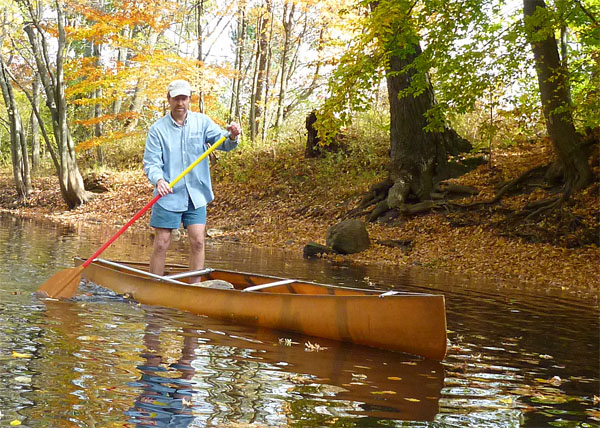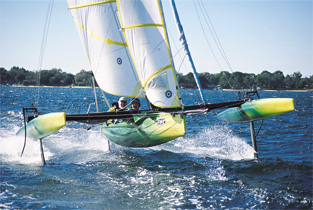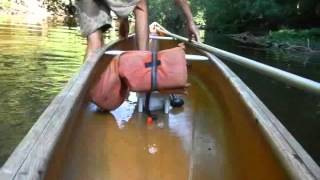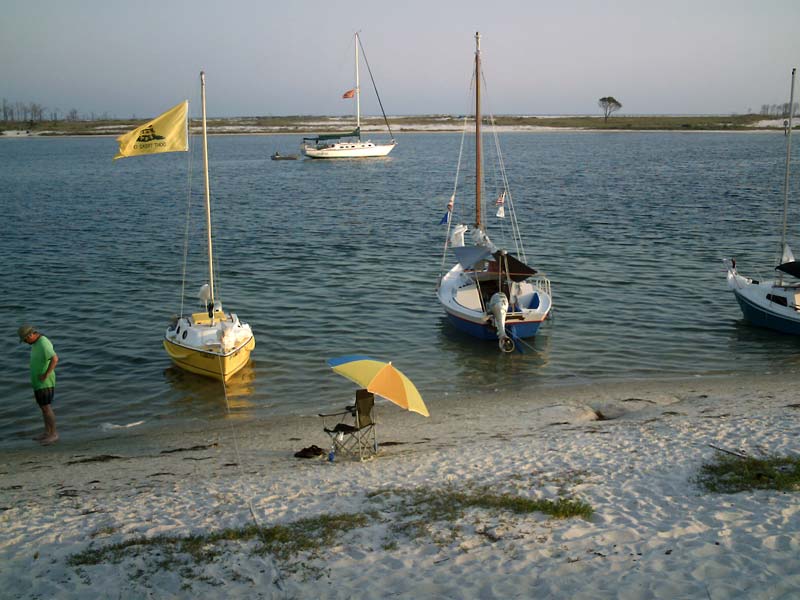More Photos Below!Gallery
Here’s the various SUC and Poling concepts wrapped into one. It’s the text from a story of mine that “Silent Sports” ran… It’s a nice summary of the “Everyman” variations on SUP that I’m promoting.
But, first, here are links to a couple videos on it!
www.youtube.com/watch?v=7ImrOoB3LDQ
www.youtube.com/watch?v=7In59ezFbm0
New Ways to SUP!
Try Standup Canoeing and Poling — for Better Sightseeing & Exercise
Standup paddling is all the craze. Why not do it in a canoe? That’s what I’ve been doing for years and it’s great. Who knows, maybe it’ll be the next big thing.
You know what standup paddling (SUP) is, right? It’s about having fun with really long paddles on really big surfboards. It’s a much easier way to surf the small waves of the Midwest.
Then there’s canoe poling, which has the opposite of SUP’s popularity. You may well not even know about it. But it had a heyday in the early 1980s. Maybe like so many other retro things, it’s time has come again.
I don’t know why canoe SUP (let’s avoid “SUC”) isn’t a standard part of the SUP game yet. Maybe it’s the lack of a polite acronym. Maybe it’s because of a few small limitations of canoes. Whatever it is, it’s opened up a great new way to paddle shallow water.
Poling is more commonly done by New Englanders on some whitewater. It’s also part of southern swamp life. Where I live in Michigan, I’ve found that it’s great way to navigate protected shallow water, for going both upstream and down, and that it offers a big turn of speed, too.
Boards obviously go well with surf. But millions of miles of rivers and most acres of a lakes have no surf. Canoes work well on the latter – on flatwater and the gentle rolling waves.
I stumbled onto poling when I was paddling our neighborhood river one gorgeous autumn. The water gets low then, often less than a foot deep, and paddling hardly works. The boat generates a big wave and bogs down. That’s why it’s called “suckwater” and is disliked by paddlers. Sitting down low and paddling so slow, I felt trapped. The tree colors overhead were blazing, but I wanted to see more.
So I stood up.
Now, I was paddling a tippy flatwater canoe, a beat up old Wenonah Advantage (16-foot 6-inches long, Kevlar, 28 pounds). Yet I found that I could balance easily. So I jumped out, whittled a 12-foot maple sapling right then and there (1.5 inches in diameter), hopped back in and took off like a rocket. No more suckwater. Gorgeous views far and wide. And plenty of speed. I was hooked.
Sure, I fell in a couple times, but it was just a matter of stepping out of the boat when unbalanced. I got less wet than falling in from a sitting position. I laughed out loud at how harmless my spills were. It was an instant breakthrough to previously unknown fun.
When it got so shallow that I rubbed bottom, I just stepped out and walked the boat by its bow painter like a dog on a leash, stepping back in after the too shallow portion. That still gives me a big grin. Trying to stay in the boat and pry up through such sections is misery. So I stood up and changed the game.
I discovered actual stand-up canoe paddling in the same ad-hoc manner, long before surf SUP. I was canoeing on a pond with my wife who was laying back and reading. I was using an old long paddle. I was already hooked on poling, but the water was too deep for that. I felt like I needed more power. So, once again, I just stood up. And I was really able to put my body into the paddle and make that heavy old boat glide along.
In short, sitting in a canoe can seem so confining once you’ve learned how easy and stable it is to stand.
The downsides I’ve encountered: You can bark your shin on the gunnel if and when you wipe out. The wind grabs hard at your tall body, canoe hull and bow if it isn’t all in balance. And waves can be tricky at first.
The advantages are many, though: A lot of us already have canoes. A canoe can haul people and cargo and it keeps things dry. It’s easier to find a fast canoe than a fast board. Again, not much water in the Midwest is good for surfing. And not everyone even wants to surf.
Learn by Doing
But there is little about either poling or standup canoeing in the media, print or online. I’m sure that, like poling, standup canoeing has been done for eons. Natives in dugouts still do it. And it’s a guide skill for briefly getting more height to read the river ahead.
On a board, you stand above the waterline, and in a canoe, you’re below it. But when I paddle either way, I don’t really notice a difference. Poling is so much more stable than paddling. When poling, you push off a nice, solid bottom. You can rely on it and lean on it.
Standup is like riding a bike. When you’re moving, you’re stable. It’s a little like several sports, actually. With the footwork and body English, it’s like snowboarding and windsurfing. You can lean, bank and cut a small canoe around obstacles. I also found it to be like cross-country skate skiing as I plant my pole or paddle and “V1” off of it.
You can get your whole body into the action. I can really exercise arms, torso and even legs with standup canoeing. One shove sends me about a boat length downriver.
Standup has so many things going for it. You get a far better view of the water all around. I was amazed at how much more aquatic life I saw. It was like floating in air over the river bottom. You also see farther across the water and beyond the riverbanks. Reflections of the sky, clouds and trees are crisper, so don’t forget your polarized sunglasses. They’re a must for gauging water depth. It’s so easy to hit things in shallow water.
Autumn is when our local mid-Michigan rivers are most clear and shallow. Perfect for poling. It’s surprising how warm the water stays until November. When it’s too shallow, I get out and pull the boat, but I never get chilled. It’s easy walking, too. The river actually feels more like a trail when doing standup.
I used to quit paddling during this colorful time of year because of the low water level. The leaves bunched up on my bow. Now when I stand in my canoe, I just lean back to lift my bow out of the water and shed the leaves before me.
Where there are a lot of blowdowns, and I’m in and out of the boat a lot, I call it boatocross or cross-country paddling. I try to hurdle obstacles without breaking my flow, like cyclocross racers do as they dismount and remount while keeping up their speed. It’s easier to navigate small, choked waterways than when sitting.
When you encounter obstacles you can even stay in the boat much of the time. Just put your weight on the pole/paddle, unweight your feet and hop-skotch the boat over that not-deep-enough log in one shove. Or move aft, push the boat part way over the log, trot to the front, then see-saw the boat over the rest of the way. Tah-dah!
Fashioning a Paddle or Pole
I made my own 6-foot 6-inch paddle (which seemed to fit me, as I’m 6 feet tall) by splicing hollow Kevlar paddle shafts together. It’s heavy and flexy, noticeably wasting my effort. Carbon is clearly best for a long performance paddle.
It’s easy to buy SUP paddles nowadays. If you buy one of those, make sure you adjust for the lower position of a canoe. It’s worth it to splurge on a light carbon model. Wood might be fine in the blade and grip. Whatever you do, make sure it’s stiff. The stiff lightness of carbon might be the key to the popularity of SUP.
There was a bit of a poling heyday in canoeing’s own heyday in the early 1980s and light two-piece aluminum poles were sold for over $100, but no more. I’m lucky to have one and it’s still great. It cost more than $200 in today’s dollars!
Thankfully, I am now making high quality canoe poles available once again! Just email me or search my website for my catalog listing and a clickable PayPal button. For $50 I’ll mail you a two-piece tempered 12-foot pole with a 1-foot splicing plug that you glue in. My 2-piece pole is 1 1/8″ diameter, .065″ wall. I also sell a 1-piece pole of 1″ — I like the feel of 1″ better — but it’s only suitable for local pickup. (Can’t mail a 12-foot tube!) I suppose those with XL hands might prefer the 1 1/8″. (To make a 2-piece collapsible you can glue one end and flush-bolt the other, but I’ve never needed to collapse mine. Everywhere my 16-ft canoe goes my 12-ft pole can easily tag along!)
You can also buy a classic $100 wooden pole from an outfitter, but these are intended as “setting poles” for whitewater. They can be heavy for traveling a significant distance in a canoe.
There are plans available online for making your own pole out of either wood or aluminum. A closet pole or a clear ash or spruce board would work.
A sapling will last fairly long, especially if you whittle the bark and let it dry and air harden. But, remember, if your sapling is tapered very much you’ll use a one-sided technique, as a result it should also be longer, more like 14 feet, since one-sided poling is best done hand-over-hand on down the pole. Of course, you can use any pole length or technique that works!
Speaking of length, you can also make a pole for SEATED poling, a la Verlen Kruger! He used a 6-foot aluminum pole that he kept lashed to his deck. He often deployed it when going upstream next to the river bank and would even use it on the dry land next to him.
To make your own aluminum pole, you need to use tempered metal, 1″ to 1 1/8″ inches in diameter and a .058-inch to .065″ wall. When buying on your own from an aluminum retailer this can cost about $5 a foot. So you’re looking at $70 in materials, including the cost of two mailable 6-foot sections with a plug or coupler sleeve. Better to buy direct from me! I buy at wholesale and have bulk inventory.
There are a couple places in New England where you can buy pole ends, but again, you can make your own. Some pole ends have a duck foot that spreads to keep a pole from sinking too far into mud. The other end of a real setting pole often has a short rock stud for purchase on rocky bottoms. I find that Michigan river bottoms aren’t too mucky or rocky. My old naked maple sapling held up just fine. My aluminum pole is just plain pipe.
Poling with a sapling is much more one-sided. A sapling is used thick end down. It’s heavier and flexier than aluminum so your cadence will be slower.
I take along all three tools: paddle, pole and SUP paddle. I suppose I do about one-third of an outing in each mode. For a given river section, one mode just fits best.
Technique
For both poling and paddling, I stand behind the seat of my C1 and press my shin up against a thwart that has plumber’s foam insulation around it. I usually position my feet somewhat fore and aft. This lets me make dynamic shifts, so if I ram into something I won’t lose balance. Official poling and surf SUP style has you position your feet side-by-side, which I do in more stable conditions.
SUP is like regular paddling but with a bit of knee flexing and butt drop as you hit the stroke. The key is to keep an internal center of gravity. Do not put weight on the paddle unless you’re bracing.
For poling, I stand tall, reach forward, drop the pole in the water a couple feet in front of me, plant the pole at an angle (it’ll bite into the riverbed a foot or so below), collapse onto the pole, do an ab crunch, flex my legs a little bit, shoving to the rear and letting go of my lower hand to get a nice long push. Then I rise up, tilt the pole to the other side and plant the other end. When I’m really going for it, I shift weight to my forward foot and reach way out.
With poling, you use your abs as much as your arms for power. You kind of hang from your hands. Keep the elbows low and tucked in. Remember, your shoulders are weak and prone to injury when your elbows are high or extended.
I shuffle my hands as conditions require. Sometimes I walk my hands down the pole. Sometimes I do a “cross-bow draw” move, where I change sides without changing hand position, letting go of the trapped lower hand as I shove. I occasionally do a little baton twirling when faced with overhanging branches.
Sometimes to run straight I have to stand a bit toward the side I’m poling on, lifting the other side up. This lets the curve of the tumblehome compensate for the powerful shove. And you want an evenly trimmed waterline for best glide.
Also, if you plant your pole forward toward the bow, you can snub your speed or spin your boat – key skills on the whitewater side of poling.
Standup isn’t for everyone. But if you balance well on a surf SUP, snowboard or the like, then you’re good to go. Practice in the shallows. When getting in and out and negotiating obstacles, using tricks like the teeter-totter, move around in your boat the same as always by putting your hands on the gunnels. I still get jittery the first few times I turn sideways and around in my race canoe.
With a sapling pole, I tend to reach forward more and drop down more in the push. If your pole has a curve, hold it so the curve lets you plant the pole further under the hull. With a sapling, I end up doing more J-strokes and corrections from one side of the boat.
I find that poling can be as fast as race paddling when in shallow water. By my watch, it’s faster going upstream and a bit slower downstream.
When I pole in water over five feet deep, I just paddle with the pole. It works well enough just swooshing it. But I usually have my standup paddle with me and switch to that for longer deep sections.
I haven’t given up on sitting down. It’s just so nice to stand, stretch, work the legs and see so much more. Standing up in canoes, for paddling and poling has added a whole new range of experience and motion for me. I’m sure glad I stumbled onto it.
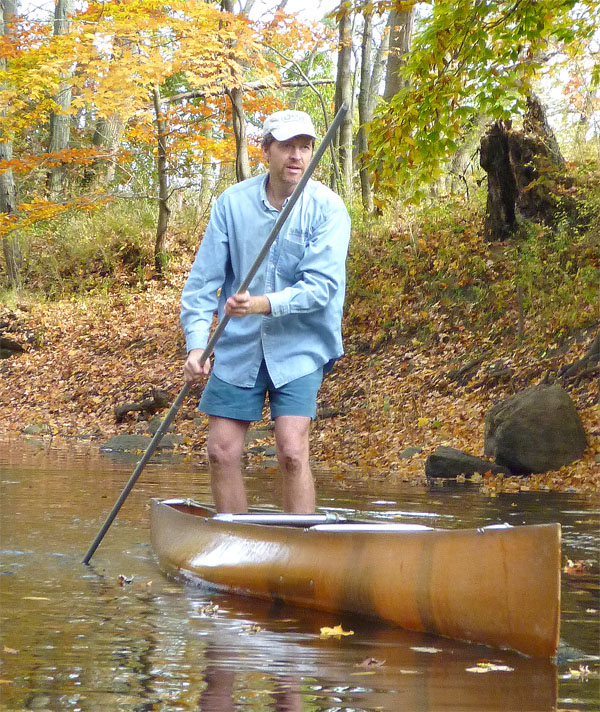
Poling is the best. It’s darn stable. It’s great training for SUP. And it’s the best way to canoe in shallow water BAR NONE. Nothing else is even reasonable, as paddling is so vexing in the shallows. So when it’s shallow, don’t stay home, go pole!
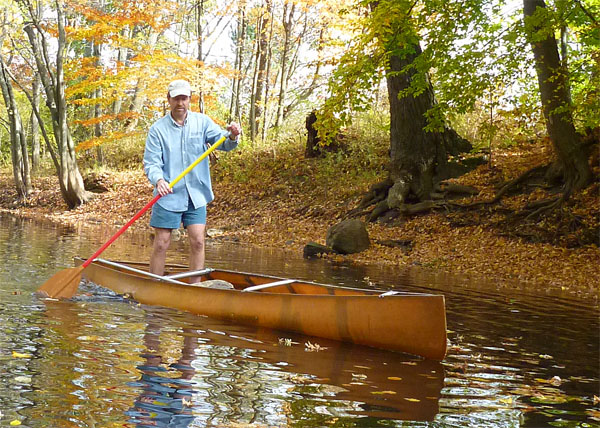
Ah, SUC. If you don’t have surf and you do have a canoe, try SUC. You’ll like it. (Wind is not your friend, however.)
